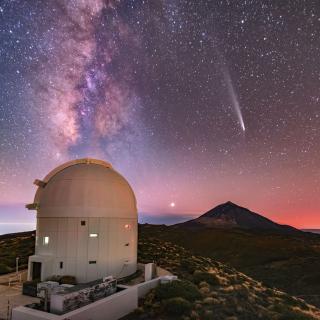It may interest you
-
 En 2025, el Instituto de Astrofísica de Canarias (IAC) celebra el cuarenta aniversario de su inauguración oficial en 1985, consolidándose como uno de los principales centros de investigación de Astrofísica a nivel internacional.Advertised on
En 2025, el Instituto de Astrofísica de Canarias (IAC) celebra el cuarenta aniversario de su inauguración oficial en 1985, consolidándose como uno de los principales centros de investigación de Astrofísica a nivel internacional.Advertised on -
 Astronomers at the Instituto de Astrofísica de Canarias (IAC), using the 2-meter robotic Two-meter Twin Telescope (TTT) at the Teide Observatory, have obtained the deepest optical images ever taken of Malin 2, one of the largest and faintest spiral galaxies in the Universe. These ultra-deep observations have revealed previously unseen structures, including several diffuse stellar emissions and a striking, elongated spiral-like feature, hinting at past interactions with other galaxies. The team has also identified a potential ultra-diffuse dwarf galaxy (UDG) about 400,000 light-years fromAdvertised on
Astronomers at the Instituto de Astrofísica de Canarias (IAC), using the 2-meter robotic Two-meter Twin Telescope (TTT) at the Teide Observatory, have obtained the deepest optical images ever taken of Malin 2, one of the largest and faintest spiral galaxies in the Universe. These ultra-deep observations have revealed previously unseen structures, including several diffuse stellar emissions and a striking, elongated spiral-like feature, hinting at past interactions with other galaxies. The team has also identified a potential ultra-diffuse dwarf galaxy (UDG) about 400,000 light-years fromAdvertised on -
 The European Solar Telescope (EST) project has taken a decisive step towards construction with the establishment of the Board of Governmental Representatives (BGR), marking the first formal commitment at the governmental level to this European flagship in solar research. Until now, EST has been driven by a scientific consortium of universities and research institutions across Europe. The creation of the BGR transforms EST into a collaboration among European nations, whose national governments lend political support to the project and to the creation of a future European Solar TelescopeAdvertised on
The European Solar Telescope (EST) project has taken a decisive step towards construction with the establishment of the Board of Governmental Representatives (BGR), marking the first formal commitment at the governmental level to this European flagship in solar research. Until now, EST has been driven by a scientific consortium of universities and research institutions across Europe. The creation of the BGR transforms EST into a collaboration among European nations, whose national governments lend political support to the project and to the creation of a future European Solar TelescopeAdvertised on
